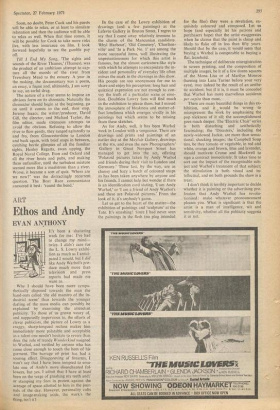ART
Ethos and Andy
EVAN AN,THONY
It's been a shattering week for me: I've had to change my mind— twice. I didn't care for the L. S. Lowry exhibi- tion as much as I antici- pated I would, but I did like Andy Warhol's pro- duce much more than television and press reports had made me want to.
Why I should have been more sympa- thetically disposed towards the man the hand-outs called 'the old maestro of the in- dustrial scene' than towards the younger darling of the mass media can possibly be explained by examining the attendant publicity. To those of us grown weary of, and supposedly impervious to, the efforts of clever publicists, the picture of Lowry as a craggy, sharp-tongued recluse makes him immediately more palatable and acceptable as a talent one needn't hesitate to revere than does the role of trendy Wunderkind assigned to Warhol, and verified by anyone who has come close enough to touch the hem of his garment. The barrage of. print has had a souring effect. Disapproving of firearms, I won't say that I have been tempted to emu- late one of Andy's more disenchanted fol- lowers, but yes, I admit that I have at least' been on the verge of gnashing my teeth and/ or stamping my foot in protest against the acreage of space allotted to him in the jour- nals of the day. However, personality cults and image-making aside, the work's the thing, isn't it? In the case of the Lowry exhibition of drawings (and a few paintings) at the Lefevre Gallery in Bruton Street, I regret to say that I came away relatively immune to the charm of the Mancunian candidate. `Rhyl Harbour', 'Old Cemetery', 'Chorlton- ville' and 'In a Park No. l' are among the more successful items, well illustrating the unpretentiousness for which this artist is famous, but the almost caricature-like style with which he attempts to encapsulate the in- cident and personality of everyday life often misses the mark in the drawings in this show. His people are too anonymous for me to share and enjoy his perception; long hair and quizzical expression are not enough to con- vey the truth of a particular scene or emo- tion. Doubtless Lowry fans will find much in the exhibition to please them, but I missed the atmosphere of bleakness and matter-of- fact loneliness which emerges vividly in his paintings but which seems to be missing from these sketches.
As for Andy, well, it has been Warhol week in London with a vengeance. There are drawings and prints and paintings of an earlier day at the Mayfair Gallery, drawings at the ICA, and even the new Photographers' Gallery in Great Newport Street has managed to get into the act, offering 'Polaroid pictures taken by Andy Warhol and friends during their visit to London and Germany.' These last, by the way, are as clumsy and hazy a batch of coloured snaps as has been taken anywhere by anyone and his friends. I cannot help but wonder if there is an identification card stating, 'I am Andy Warhol,' or 'I am a friend of Andy Warhol's and these are Polaroid pictures.' From the look of it, it's anybody's game.
Let us get to the heart of the matter—the exhibition of paintings and 'sculpture' at the Tate. It's smashing! Since I had never seen the paintings in the flesh (no plug intended for the film) they were a revelation, ex- quisitely coloured and composed. Let us hope (and especially let his patrons and purchasers hope) that the artist exaggerates when he claims that the paint is cheap and likely, to flake off in less than fifty years. Should that be the case, it would seem that buying a Warhol is comparable to buying a flat, leasehold.
The technique of deliberate misregistration in screen printing, and the composition of multiple images, be it of a few dozen squares of the Mona Lisa or of Marilyn Monroe (turning into Lana Turner before your very eyes), may indeed be the result of an aesthe- tic accident, but if it is, it must be conceded that Warhol has more marvellous accidents per capita than most.
There are many beautiful things in this ex- hibition, and it would be wrong to misrepresent the work by emphasising the pop slickness of it all; the accomplishment goes much deeper. The 'Electric Chair' series is both disturbing and aesthetically fascinating; the 'Disasters,' including the newly-widowed Jackie, are more than sensa- tional, shocking images; the Campbell Soup tins, be they tomato or vegetable, in red and white, orange and brown, blue and lavender, should motivate Crosse and Blackwell to sign a contract immediately. It takes time to sort out the impact of the recognisable sub- ject and Warhol's treatment of that subject; the stimulation is both visual and in- tellectual, and on both grounds the show is a treat.
I don't think it terribly important to decide whether it is painting or the advertising pro- fession that Andy Warhol has revolu- tionised: make whatever pronouncement pleases you. What is significant is that the artist is a man of intelligence, wit and sensitivity, whether all the publicity suggests it or not.


































 Previous page
Previous page